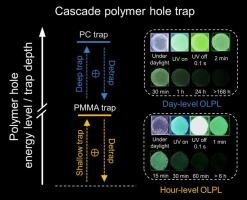Day-level long persistent luminescence in purely organic polymers via cascade hole trap mechanism
IF 22
1区 材料科学
Q1 MATERIALS SCIENCE, MULTIDISCIPLINARY
引用次数: 0
Abstract
Significant advances have been made in organic long persistent luminescence (OLPL) materials, particularly in achieving hour-level room-temperature emission through charge-separation mechanisms in host–guest systems. Nevertheless, realizing such performance using commercially available, low-cost optoelectronic-inert polymers as host matrices remains a substantial challenge. In this work, we report hour-level room-temperature OLPL in common inexpensive polymer hosts, including poly(methyl methacrylate) (PMMA), poly(L-lactic acid) (PLLA), poly(vinyl acetate) (PVAc), and polystyrene (PS), by incorporating electron-deficient naphthalenediimide derivatives as guest molecules. Remarkably, a combination of commercially available PMMA with polycarbonate (PC) yields an unprecedented day-level OLPL duration exceeding 168 h. We propose a cascade polymer hole trap mechanism to explain this exceptional performance. Beyond demonstrating potential for large-area fabrication and nighttime illumination, these materials exhibit stable emission under various extreme conditions and enable multi-layer information encryption. This breakthrough expands the prospects for OLPL materials to potentially supplant conventional inorganic counterparts in future applications.

通过级联空穴陷阱机制在纯有机聚合物中产生日级长持续发光
有机长持续发光(OLPL)材料取得了重大进展,特别是在主客体系统中通过电荷分离机制实现小时级室温发射。然而,利用商业上可获得的低成本光电惰性聚合物作为宿主基质实现这种性能仍然是一个重大挑战。在这项工作中,我们报道了在常见的廉价聚合物宿主中,包括聚甲基丙烯酸甲酯(PMMA)、聚l -乳酸(PLLA)、聚醋酸乙烯(PVAc)和聚苯乙烯(PS),通过将缺电子的萘二亚胺衍生物作为客体分子,实现了小时级室温OLPL。值得注意的是,商用PMMA与聚碳酸酯(PC)的结合产生了前所未有的超过168小时的日间OLPL持续时间。我们提出了一个级联聚合物空穴陷阱机制来解释这种特殊的性能。除了展示大面积制造和夜间照明的潜力外,这些材料在各种极端条件下表现出稳定的发射,并能够实现多层信息加密。这一突破扩大了OLPL材料在未来应用中取代传统无机材料的前景。
本文章由计算机程序翻译,如有差异,请以英文原文为准。
求助全文
约1分钟内获得全文
求助全文
来源期刊

Materials Today
工程技术-材料科学:综合
CiteScore
36.30
自引率
1.20%
发文量
237
审稿时长
23 days
期刊介绍:
Materials Today is the leading journal in the Materials Today family, focusing on the latest and most impactful work in the materials science community. With a reputation for excellence in news and reviews, the journal has now expanded its coverage to include original research and aims to be at the forefront of the field.
We welcome comprehensive articles, short communications, and review articles from established leaders in the rapidly evolving fields of materials science and related disciplines. We strive to provide authors with rigorous peer review, fast publication, and maximum exposure for their work. While we only accept the most significant manuscripts, our speedy evaluation process ensures that there are no unnecessary publication delays.
 求助内容:
求助内容: 应助结果提醒方式:
应助结果提醒方式:


